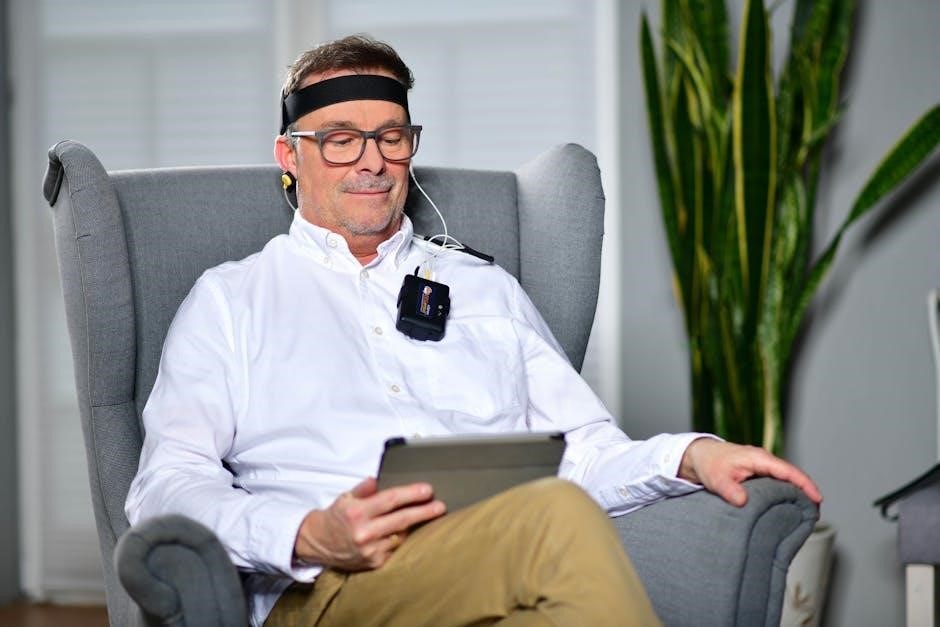EEG electrode placement is crucial for accurate brain activity recording. The 10-20 system standardizes electrode positioning, ensuring consistency and reproducibility in both clinical and research settings. This method, detailed in 10-20 EEG electrode placement PDF guides, provides a universal framework for electrode locations, enabling reliable data interpretation and comparison across studies. Proper placement adheres to specific anatomical landmarks, ensuring optimal signal capture and minimizing artifacts. Understanding this system is essential for researchers and clinicians to ensure high-quality EEG recordings.
Overview of EEG and Its Importance
Electroencephalography (EEG) is a non-invasive neuroimaging technique that records electrical activity of the brain through electrodes placed on the scalp. It is widely used in both clinical and research settings to diagnose neurological disorders, monitor brain activity, and study cognitive processes. EEG’s importance lies in its ability to provide real-time insights into brain function, making it invaluable for understanding conditions like epilepsy, stroke, and brain injuries. Its non-invasive nature and high temporal resolution allow for safe and detailed analysis of neural activity, supporting advancements in neuroscience and patient care. Standardized systems, such as the 10-20 system, ensure accurate and reproducible recordings.
Role of the 10-20 System in EEG Electrode Placement
The 10-20 system plays a pivotal role in EEG electrode placement by providing a standardized method for positioning electrodes on the scalp. This system ensures consistent and reproducible recordings, which are essential for both clinical and research applications. It divides the scalp into specific regions, with electrodes placed at intervals of 10% or 20% of the distance between key anatomical landmarks. This standardized approach allows for accurate comparison of EEG data across different studies and institutions. By maintaining uniform electrode spacing, the 10-20 system enhances the reliability and interpretability of EEG results, making it a cornerstone of electrophysiological assessments.

What Is the 10-20 EEG Electrode Placement System?
The 10-20 EEG system is a standardized method for placing electrodes using 10% and 20% intervals between anatomical landmarks, ensuring consistent and reproducible recordings.
History and Development of the 10-20 System
The 10-20 EEG electrode placement system was first introduced in the 1950s by the International Federation of Clinical Neurophysiology. It was developed to standardize electrode positions, ensuring reproducibility across studies. The system divides the scalp into segments based on 10% and 20% intervals between key anatomical landmarks, such as the inion and nasion. This proportional approach allows electrodes to be placed consistently, regardless of head size or shape. Over time, the system has evolved, with extensions like the 5% system for higher-resolution recordings. Its widespread adoption has made it a cornerstone of EEG research and clinical applications.
Key Principles of the 10-20 System
The 10-20 system relies on standardized electrode placement using 10% and 20% intervals between anatomical landmarks like the nasion, inion, and auricular points. This ensures proportional placement across diverse head sizes. Electrodes are labeled with letters (e.g., F for frontal, P for parietal) and numbers (odd for left, even for right, midline as z). The system balances simplicity with flexibility, allowing for consistent recordings. Its universality enables data comparison across studies. Extensions like the 5% system enhance resolution for specialized applications, while maintaining the core principles of the original framework.
Standardization and universality of the 10-20 System
The 10-20 system is globally recognized for its standardized electrode placement, ensuring consistency across EEG studies. Its universality allows researchers and clinicians to compare data seamlessly, facilitating collaboration worldwide. Standardized labels and positions enable reproducibility, making it a cornerstone of EEG research and clinical applications.
This system’s widespread adoption stems from its ability to accommodate diverse head shapes and sizes while maintaining precise electrode placement. Its universal acceptance ensures that EEG recordings are reliable and comparable, fostering advancements in neuroscience and diagnostics.

Electrode Labels and Naming Conventions
EEG electrodes are labeled using a standardized system, such as the 10-20 system, ensuring consistent identification of positions like Fp, F, C, and T for frontal, central, and temporal regions.
Standard Naming Convention for EEG Electrodes
The standard naming convention for EEG electrodes follows the 10-20 system, where labels like Fp (frontopolar), F (frontal), C (central), T (temporal), P (parietal), and O (occipital) denote specific scalp regions. These labels are universally adopted to ensure consistency in electrode placement and interpretation. Suffixes such as “z” for midline electrodes (e.g., Cz) and “s” for supplementary positions are also used. The system includes designations for left (odd numbers) and right (even numbers) hemispheres, with the reference electrode often placed at sites like A1 or A2. This naming convention is detailed in 10-20 EEG electrode placement PDF guides, ensuring clarity and reproducibility across studies.
Common Electrode Locations and Their Labels
The 10-20 system identifies common EEG electrode locations with standardized labels. Key positions include frontal electrodes (Fp, F3, F4, F7, F8, Fz), central electrodes (C3, C4, Cz), parietal electrodes (P3, P4, Pz, P7, P8), temporal electrodes (T3, T4, T5, T6), and occipital electrodes (O1, O2, Oz). Midline electrodes (Fz, Cz, Pz) are placed along the scalp’s sagittal midline. Hemispheric differentiation is indicated by odd (left) and even (right) numbers. Reference electrodes, such as A1 and A2, are often placed on the earlobes. These labels, detailed in 10-20 EEG electrode placement PDF guides, ensure precise and consistent electrode placement for accurate recordings.

EEG Electrode Placement Methodology
The 10-20 system offers a systematic electrode placement method using anatomical landmarks, ensuring consistency and reproducibility in EEG recordings, as detailed in 10-20 EEG electrode placement PDF guides.
Preparation Steps for EEG Electrode Placement
Preparation is critical for accurate EEG recordings. Begin by cleansing the scalp to remove oils and dirt, ensuring good electrode contact. Measure and mark anatomical landmarks, such as the nasion, inion, and preauricular points, to guide placement. Use a measuring tape or EEG cap to determine electrode positions based on the 10-20 system. Apply electrodes securely, using conductive gel or paste to reduce impedance. Ensure proper fit to minimize movement artifacts. Refer to 10-20 EEG electrode placement PDF guides for detailed instructions and diagrams, ensuring consistency and accuracy in electrode placement.
Measuring and Marking the Scalp for Electrode Placement
Measuring and marking the scalp are essential for accurate electrode placement in the 10-20 system. Begin by identifying key anatomical landmarks, such as the nasion (bridge of the nose), inion (back of the head), and preauricular points (front of the ears). Use a flexible measuring tape to divide the scalp into segments, ensuring proportional placement. For example, the distance between the nasion and inion is divided into 20% increments for midline electrodes. Mark these points with a washable pen to guide electrode placement. This systematic approach ensures precise and reproducible positioning, as detailed in 10-20 EEG electrode placement PDF guides.
Applying Electrodes According to the 10-20 System
Applying electrodes according to the 10-20 system involves placing them at pre-measured scalp locations. Start with reference electrodes (e.g., Cz or Pz) and proceed to other sites like Fz, P3, and O1. Use conductive gel or paste to ensure proper contact and impedance levels. Secure electrodes with adhesive or a stretchable cap. Double-check labels to match the 10-20 naming convention. Once applied, verify electrode functionality using an impedance checker. Proper placement, as outlined in 10-20 EEG electrode placement PDF guides, ensures accurate data capture and minimizes artifacts during recording.
Troubleshooting Common Issues in Electrode Placement
Common issues in electrode placement include poor contact, mislabeling, and improper scalp preparation. To address these, ensure electrodes are securely placed with adequate gel or paste for good conductivity. Verify electrode labels match the 10-20 system to prevent data misinterpretation. Clean the scalp thoroughly and trim excess hair to enhance signal quality. Minimize electrical noise by using shielded cables and ensuring a quiet environment. Account for anatomical variations by using landmarks like the nasion and inion for accurate placement. Double-check measurements to avoid errors, and ensure subject comfort by applying electrodes gently and securely. Proper troubleshooting ensures reliable EEG recordings.

Advantages of the 10-20 System
The 10-20 system offers standardized, universal electrode placement, ensuring consistency and reproducibility across studies. Its simplicity reduces variability, enabling accurate and reliable EEG data collection and interpretation.
Why the 10-20 System Is Widely Used
The 10-20 system is widely used due to its standardized and universal approach to EEG electrode placement. It ensures consistency and reproducibility across studies, making it easier to compare results. The system’s simplicity reduces variability, enabling accurate and reliable data collection. Its adaptability to various EEG applications, from clinical diagnostics to research, further enhances its popularity. Additionally, the 10-20 system provides a clear framework for electrode labeling and placement, facilitating communication among researchers and clinicians worldwide. These advantages make it a cornerstone in both clinical and research settings for EEG recordings.
Flexibility and Adaptability of the System
The 10-20 system’s flexibility allows it to adapt to various EEG recording needs. It accommodates different electrode densities, from standard setups to high-resolution configurations. This adaptability supports both clinical diagnostics and advanced research applications. The system’s scalability enables its use in studies ranging from basic brain function analysis to complex neurological disorders. Its universal compatibility with EEG equipment ensures seamless integration into diverse experimental designs. This flexibility makes the 10-20 system a versatile tool, capable of meeting the demands of both routine and specialized EEG recordings across different disciplines and technologies.

Limitations of the 10-20 System
The 10-20 system has limitations, including low spatial resolution and inability to cover all brain regions equally. It lacks flexibility for specialized or high-resolution EEG recordings.
Drawbacks of the 10-20 System
The 10-20 system has several drawbacks, including limited spatial resolution and inadequate coverage of certain brain regions. It often fails to accurately capture activity in areas like the medial temporal lobe, which is critical for epilepsy research. Additionally, the system’s fixed electrode spacing may not accommodate varying skull sizes or shapes, potentially leading to suboptimal signal quality. Its lack of flexibility makes it less suitable for high-resolution EEG or specialized studies requiring dense electrode arrays. These limitations highlight the need for complementary or alternative systems for advanced neurological assessments.
Alternatives to the 10-20 System
Beyond the 10-20 system, alternatives like the 5% system and dense array EEG offer higher spatial resolution for specialized applications. The 5% system reduces inter-electrode distances, enabling precise mapping of brain activity, while dense array systems use up to 256 electrodes for high-resolution recordings. These methods are particularly useful in research and clinical settings requiring detailed data, such as epilepsy monitoring or cognitive studies. Additionally, systems like the sphenoidal electrode placement target specific brain regions, such as the medial temporal lobe, which the 10-20 system may not adequately cover. These alternatives enhance flexibility and accuracy in EEG recordings.
Applications of the 10-20 System in EEG
The 10-20 system is widely used in both research and clinical settings for studying brain activity, cognitive functions, and diagnosing conditions like epilepsy. It aids in sleep studies, seizure monitoring, and mapping neural processes, making it a versatile tool in neuroscience and neurology.
Research Applications of the 10-20 System
The 10-20 system is extensively used in research to study brain activity, cognitive processes, and neural dynamics. It facilitates the investigation of event-related potentials (ERPs), motor and sensory functions, and brain oscillations. Researchers rely on its standardized electrode placements, such as F3 for left prefrontal cortex activity or Pz for posterior regions, to ensure consistent data collection. The system’s universality allows for easy comparison of findings across studies, making it a cornerstone in neuroscience research. Additionally, it supports high-density EEG studies by providing a foundational framework for electrode placement, enabling deeper insights into brain function and behavior.
Clinical Applications of the 10-20 System
The 10-20 system is vital in clinical settings for diagnosing and monitoring neurological conditions. It is commonly used in epilepsy to detect seizure activity, in ICUs to monitor brain function, and in assessing encephalopathy and brain injuries. The system aids in localizing seizure foci for epilepsy surgery and is integral to sleep studies for diagnosing disorders like insomnia or sleep apnea. Standardized electrode placement ensures consistent and reproducible recordings, which are critical for accurate clinical decision-making and effective treatment monitoring. This makes the 10-20 system indispensable in daily clinical practice for neurologists and healthcare professionals, aiding in precise diagnostics and treatment plans.
Comparison with Other EEG Systems
The 10-20 system is compared to dense array EEG and the 5% system. Dense array offers higher resolution, while the 5% system provides finer spatial sampling for precise brain activity mapping.
Dense Array EEG vs. 10-20 System
Dense array EEG systems use up to 256 electrodes, offering higher spatial resolution compared to the 10-20 system. This allows for more precise localization of brain activity, especially in conditions like epilepsy. The 10-20 system, with fewer electrodes, is more practical for routine clinical use and research, ensuring standardization and ease of application. Dense array systems are bulkier and more expensive, limiting their accessibility. While the 10-20 system provides a balanced approach for general applications, dense array EEG is favored for high-resolution mapping and complex neurological studies, offering deeper insights into brain function and dynamics.
The 5% System and High-Resolution EEG
The 5% system enhances EEG resolution by spacing electrodes at 5% intervals along the scalp, unlike the 10-20 system’s 10% and 20% spacing. This allows for more precise brain activity mapping, especially in research and complex neurological conditions like epilepsy. High-resolution EEG with the 5% system captures finer details, improving source localization and reducing spatial aliasing. While it offers superior spatial fidelity, its complexity and higher cost limit its use compared to the 10-20 system. The 5% system is ideal for advanced studies requiring detailed cortical activity representation, complementing the standard 10-20 system’s practicality and accessibility.

Resources and Guides for EEG Electrode Placement
Various 10-20 EEG electrode placement PDF guides and manuals provide detailed instructions, diagrams, and best practices for accurate electrode positioning. These resources are essential for both novice and experienced practitioners, ensuring consistency and precision in EEG recordings. They often include step-by-step protocols, anatomical landmarks, and troubleshooting tips to optimize electrode placement. Additionally, many guides cover related tools and software, making them comprehensive references for EEG studies and clinical applications.
PDF Guides and Manuals for 10-20 System
10-20 EEG electrode placement PDF guides are widely available, offering comprehensive instructions for accurate electrode positioning. These manuals include detailed diagrams, step-by-step protocols, and anatomical landmarks to ensure proper placement. They often cover troubleshooting tips to address common issues like poor signal quality or electrode misplacement. Designed for both researchers and clinicians, these guides standardize the process, ensuring consistency across studies. Many resources also include sections on tools and software, making them indispensable for anyone working with EEG electrode placement. These PDF guides are reliable references for achieving high-quality recordings.
Tools and Software for EEG Electrode Placement
Various tools and software aid in accurate EEG electrode placement following the 10-20 system. EEGLAB and Brainstorm are popular software options for visualizing and analyzing electrode positions. Additionally, 3D modeling tools create personalized head models to guide placement. Some systems use robotic arms or laser-guided devices for precise electrode positioning. OpenViBE and Curry are other software solutions that support electrode placement planning. These tools help ensure consistency, reduce errors, and improve the quality of EEG recordings. They are particularly useful for researchers and clinicians working with complex electrode configurations or high-density EEG systems.
The 10-20 EEG electrode placement system remains a cornerstone of neurophysiological recordings, offering standardized, reproducible results. Its adaptability ensures continued relevance in advancing EEG research and clinical applications.
The 10-20 system is a foundational method for EEG electrode placement, ensuring standardized and reproducible recordings. Its universal acceptance facilitates consistent data interpretation across studies, enhancing collaboration and comparability in research and clinical settings. By providing clear anatomical landmarks, the system minimizes variability, enabling accurate signal capture and reliable results. This standardization is critical for advancing neurophysiological understanding, making the 10-20 system indispensable in both diagnostic and investigative EEG applications.
Future of EEG Electrode Placement Systems
Emerging technologies are expected to revolutionize EEG electrode placement, offering higher precision and accessibility. Advances in dense array systems and dry electrodes may complement the 10-20 system, enabling high-resolution recordings with fewer artifacts. Portable and wireless EEG devices could become more prevalent, making neurophysiological monitoring more accessible. AI-driven tools may optimize electrode placement, reducing human error and improving signal quality. These innovations aim to enhance the flexibility and scalability of EEG systems while maintaining the foundational standards established by the 10-20 system, ensuring continued advancements in both clinical and research applications.


